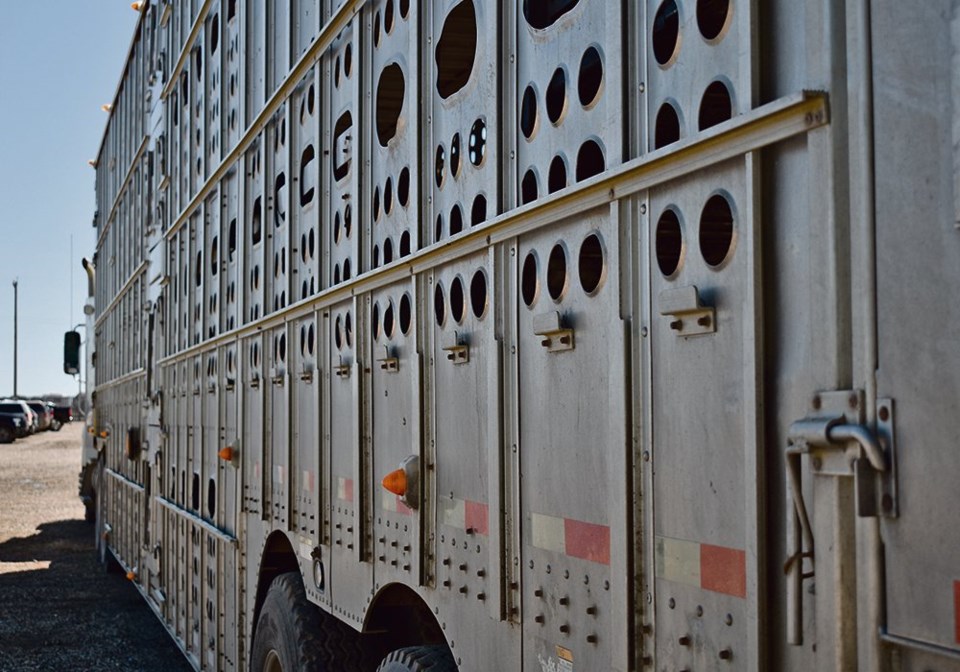WESTERN PRODUCER — Following a two-year education period to help livestock carriers adjust, the Canadian Food Inspection Agency will now enforce transport regulations enacted Feb. 20, 2020.
However, the agency noted that research into feed, water and rest-stop requirements for older beef calves and unweaned dairy calves is ongoing.
“As such, the CFIA does not plan to prioritize enforcement efforts where the maximum intervals (of 36 hours) without FWR (feed, water, rest) for ruminants of nine days of age and older are exceeded by less than four hours and where all animal welfare outcomes are being met (not exceeding 40 hours),” the agency replied in response to a request for more information.
Amendments to the Health of Animals regulations were first published in 2019 but industry said some weren’t necessarily in the animals’ best interests. They said unloading animals for feed, water and rest could be more stressful than a long haul, and there aren’t enough places to unload cattle to do this.
The regulations allow no more than 12 hours on a truck for unweaned animals, and a maximum of 36 hours for weaned animals, with a required eight-hour rest stop.
Dr. Karen Schwartzkopf-Genswein, a researcher at the federal research centre in Lethbridge, found the difference between calves transported for 36 hours or 12 hours, with and without rest stops, was only some fatigue.
When she presented her work two years ago at the Saskatchewan Beef Industry conference, she noted that cattle management before transport seemed to have the greatest effect on how cattle travel. Calves in good condition can cope with transport stress regardless of how much rest they got, she said then.
Subsequent research comparing pre-conditioned and freshly weaned calves found similar results. Rest stops provided no benefits, the research found, and in fact the calves that did have a rest were not as alert.
The calves that were not pre-conditioned had less energy and ate less during the rest stop. The study suggested conditioning can improve the welfare of transported calves.
Further research is still underway.
Still, the two-year period has ended and CFIA “is moving to the full application of the standard regulatory responses process, taking into account harm, history and intent for all humane transport requirements,” the agency said late last month.
CFIA said the regulations also include feed, water and rest outcome-based requirements to make sure animals won’t suffer, be injured or die during transport.
Pat Hayes, co-chair of the animal health and care committee at the Canadian Cattlemen’s Association, said a bigger regulatory issue producers may not be aware of is that they require a transfer of care document when leaving an animal at an auction mart, assembly yard or slaughter plant.
“It’s going to be in effect and it’s going to be a surprise to a lot of people,” he said. “That document is going to be required by the transporter. Now, the transporter can be a commercial company or it can be the producer.”
CFIA said it has taken a “compliance enforcement approach” to the document even though it has technically been in place.
The transfer of care document must contain the date and time the animals arrived at the assembly point, their condition upon arrival, and when they were last fed, watered and rested.
Verified Beef Plus has developed a template available to all producers on the organization’s website. Some provinces and companies are also developing forms.
Hayes said 99.95 percent of beef cattle transported arrive at their destinations in perfect shape and the regulations were made for all sectors rather than those that might have had problems.
If cattle are going to be unloaded for feed, water and rest there is a rest station in Kapuskasing, Ont., at a former demonstration farm and another at a former goat dairy in Hallebourg, Ont.
However, Hayes said there still isn’t enough capacity to follow the regulations and he worries there could be more cattle from the United States moving north into Ontario feedlots rather than from Western Canada.
“It isn’t only the west to east,” he added. “The Maritimes are in no better position getting into Quebec and Ontario. They face these same limits on these time restraints.”




